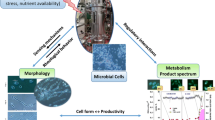Abstract
N-Acetylglucosamine and citrate promoted intensive dimorphic growth and significant lipase synthesis inYarrowia lipolytica. In contrast, use of a phosphate buffer instead of citrate for buffering the medium stimulated only dimorphic growth. No correlation between dimorphic growth and a high lipase synthesis studied in five different species of lipolytic yeasts was demonstrated. The data provide evidence against the inevitable linkage between the capability (and/or intensity) of mycelium formation and a high level of extracellular lipase in lipolytic yeasts.
Similar content being viewed by others
References
Barnett J.A., Payne R.W., Yarrow D.:Yeasts: Characteristics and Identification, pp. 528–529. Cambridge University Press, Cambridge 1973.
Ghannoum M.A., Janini G., Khamis L., Radwan S.S.: Dimorphism-associated variations in the lipid composition ofCandida albicans.J. Gen. Microbiol.132, 2367–2375 (1986).
Lloyd G.I., Morris E.O., Smith J.E.: A study of the esterases and their function inCandida lipolytica, Aspergillus niger and a yeast-like fungus.J. Gen. Microbiol.63, 141–150 (1971).
Novotný Č., Doležalová L., Musil P., Novák M.: The production of lipases by someCandida andYarrowia yeasts.J. Basic Microbiol.28, 221–227 (1988).
Olson P.M., Johnson M.J.: Factors producing high yeast yields in synthetic media.J. Bacteriol.57, 235–246 (1949).
Ota Y., Oikawa S., Morimoto Y., Minoda Y.: Nutritional factors causing mycelial development ofSaccharomycopsis lipolytica.Agric. Biol. Chem.48, 1933–1939 (1984).
Ota Y., Yamada K.: Lipase fromCandida paralipolytica. Part 3. Further studies on the activation of the enzyme system with bile or calcium salts.Agric. Biol. Chem.31, 809–810 (1967).
Rodriguez C., Dominguez A.: The growth characteristics ofSaccharomycopsis lipolytica: Morphology and induction of mycelium formation.Can. J. Microbiol.30, 605–612 (1984).
Ruschen S., Winkler U.K.: Stimulation of the extracellular lipase activity ofSaccharomycopsis lipolytica by hyaluronate.FEMS Microbiol. Lett.14, 117–121 (1982).
Sadamori S.: Comparative study of lipid composition ofCandida albicans in the yeast and mycelial forms.Hiroshima J. Med. Sci.36, 53–59 (1987).
Sugiura T., Ota Y., Minoda Y.: Effect of fatty acids, lipase activators, phospholipids and related substances on the lipase production byCandida paralipolytica.Agric. Biol. Chem.39, 1489–1494 (1975).
Zvyagintseva I.S., Ruban E.L.: Dissociation of the culture ofCandida paralipolytica and its lipase activity.Mikrobiologiya42, 743–745 (1973).
Zvyagintseva I.S., Pitryuk I.A.: Lipid turnover in yeasts in relation to their ecology.Mikrobiologiya45, 701–703 (1976).
Author information
Authors and Affiliations
Rights and permissions
About this article
Cite this article
Novotný, Č., Doležalová, L. & Lieblová, J. Dimorphic growth and lipase production in lipolytic yeasts. Folia Microbiol 39, 71–73 (1994). https://doi.org/10.1007/BF02814534
Received:
Revised:
Issue Date:
DOI: https://doi.org/10.1007/BF02814534




